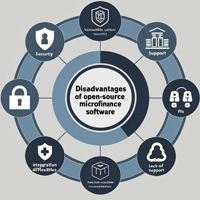
How Share Market Awareness Can Strengthen Microfinance Outcomes
Microfinance has long been celebrated as one of the most effective tools to reduce poverty, especially in developing economies like India. By providing small loans, savings opportunities, and credit facilities to low-income individuals, microfinance institutions (MFIs) empower communities to achieve financial stability. However, in recent years, experts and economists have emphasized that financial literacy is just as critical as financial access. One area that stands out in this regard is share market awareness.
Understanding the fundamentals of the stock market is not only beneficial for urban investors but can also significantly enhance the outcomes of microfinance programs in rural and semi-urban areas. When borrowers, entrepreneurs, and communities are aware of how markets work, they can make better financial decisions, diversify their income, and build resilience against economic shocks.
In this article, we’ll explore how share market awareness can strengthen microfinance outcomes, why it matters, and how institutions can work together to foster financial empowerment.
The Connection Between Microfinance and Financial Literacy
Microfinance is based on the principle of inclusion—bringing those who are typically excluded from traditional banking into the financial system. While MFIs provide the structure (credit, loans, savings options), financial literacy provides the foundation for sustainable usage of these services.
Without adequate financial literacy, microfinance clients often face challenges such as:
- Over-borrowing due to lack of budgeting skills.
- Defaulting on loans because of poor investment planning.
- Falling into debt traps when they cannot manage repayments.
- Low savings habits, leading to financial vulnerability.
Now, when share market awareness is added into the mix, it introduces clients to the concepts of investments, risks, returns, and diversification. Even if microfinance clients do not directly invest in the stock market, having an understanding of it broadens their perspective on how money can grow and how to make informed financial choices.
Also check: Why Open Source Microfinance Software Is Not the Best Choice
Why Share Market Awareness Matters in Microfinance
For decades, microfinance has focused primarily on credit disbursement. However, the global financial landscape is evolving. Households, even in rural areas, are increasingly exposed to inflation, digital payments, and financial products through smartphones.
Here are some key reasons why share market education is vital for microfinance clients:
1. Improved Financial Decision-Making
When clients understand basic stock market principles—such as returns, risks, and market cycles—they become more cautious borrowers. They start differentiating between productive borrowing (e.g., investing in a small business) and unproductive borrowing (e.g., taking loans for non-income-generating expenses).
2. Encouragement of Savings and Investment Habits
Share market awareness promotes the idea that money should not remain idle. Instead, it can grow when invested wisely. This mindset shift is crucial for microfinance borrowers who often live hand-to-mouth. By learning about investments, they begin cultivating regular saving habits.
3. Entrepreneurial Growth
Many microfinance borrowers use loans to start or expand businesses. Awareness of the share market can expose them to ideas about reinvesting profits, understanding business valuation, and identifying growth opportunities. It creates an entrepreneurial mindset that goes beyond short-term survival.
4. Risk Management Skills
Microfinance clients often face risks such as crop failure, illness, or market fluctuations in their small businesses. Learning how the share market manages risks (through diversification and long-term investing) can inspire them to apply similar risk management principles in their personal and business lives.
5. Inclusion in the Larger Financial Ecosystem
The share market is often seen as a playground for the wealthy or the urban elite. However, creating awareness among microfinance clients removes this barrier, allowing them to feel included in the broader financial ecosystem. This psychological shift is essential for empowerment and confidence-building.
Real-World Example: Rural Financial Growth Through Market Awareness
In several parts of India, NGOs and MFIs have collaborated with financial education institutions to introduce share market basics to rural communities. The results have been striking:
- Farmers began pooling small amounts into cooperative savings accounts, learning the value of collective investment.
- Women’s self-help groups started diversifying their income sources by investing in small community-based ventures, applying risk-awareness strategies learned from stock market examples.
- Young members of microfinance households, after gaining awareness, began exploring formal education in finance and eventually contributed to their families’ economic growth.
These examples show that share market literacy is not about pushing everyone to invest directly in stocks. Instead, it is about using market principles as a teaching tool to build stronger financial habits.
Also read: How Does Micro Loan Management Software Improve Lenders’ Profitability?
The Role of Institutions in Promoting Share Market Awareness
For share market education to truly strengthen microfinance outcomes, collaboration between multiple stakeholders is essential.
1. Microfinance Institutions (MFIs)
MFIs can include financial literacy sessions alongside loan disbursements. Instead of limiting training to loan repayment instructions, they can introduce concepts of savings, investments, and risk awareness.
2. Educational Institutions
Organizations that specialize in financial training can bridge the gap. For instance, Moolance Academy, one of the best share market learning institutions in Kolkata, plays a pivotal role in educating people about financial markets in a simplified manner. Such institutions can partner with MFIs to extend their reach to grassroots levels.
3. Government Initiatives
Government-backed financial literacy programs, if integrated with microfinance schemes, can amplify impact. Subsidized workshops and village-level financial education drives can ensure inclusivity.
4. Digital Platforms
With increasing smartphone penetration, mobile apps, e-learning modules, and video content on stock markets can help spread awareness at low cost. MFIs can leverage these digital solutions to train their borrowers.
Overcoming Challenges in Share Market Awareness for Microfinance Clients
While the benefits are clear, there are challenges that need to be addressed:
- Complexity of the stock market: It can be intimidating for first-time learners. Training programs must use simple, relatable language.
- Trust issues: Many people view the stock market as “gambling.” Awareness campaigns must highlight risk management and long-term strategies.
- Resource constraints: MFIs may not always have the capacity to include financial literacy. Partnerships with academies and digital platforms can help.
- Cultural barriers: In some communities, financial decision-making is dominated by men, restricting women’s involvement. Inclusive training can empower women borrowers, who form the backbone of many microfinance programs.
Long-Term Benefits of Integrating Share Market Awareness in Microfinance
If MFIs systematically incorporate share market awareness into their client programs, the long-term benefits could be transformative:
- Higher loan repayment rates due to better financial discipline.
- Increased household savings, creating a cushion against crises.
- Entrepreneurial expansion, leading to job creation in rural areas.
- Breaking cycles of poverty by shifting focus from consumption loans to productive investments.
- Greater confidence and empowerment, especially for women borrowers.
Ultimately, share market awareness acts as a multiplier effect—enhancing not just individual households’ financial health but also strengthening the overall impact of microfinance.
Conclusion
Microfinance has already proven its ability to empower millions by providing access to credit and financial inclusion. However, for its impact to be truly sustainable, financial literacy—especially share market awareness—must be integrated into the system.
By teaching borrowers the basics of investments, risks, and financial growth, MFIs can ensure that clients are not just receiving loans but are also building long-term financial resilience. Collaborations with financial training institutions, digital platforms, and government initiatives can make this possible.
As the financial ecosystem evolves, the synergy between microfinance and share market education could become a cornerstone for poverty alleviation and economic growth in India.
And when it comes to the digital backbone of microfinance operations, Gtech Web Solutions stands out as the best microfinance software company in Kolkata, offering cutting-edge solutions that empower MFIs to manage clients, loans, and operations efficiently.

